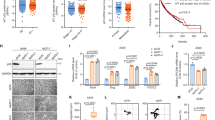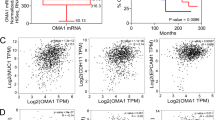Abstract
Mitochondria are highly dynamic and undergo constant fusion and fission that are essential for maintaining physiological functions of cells. Although dysfunction of mitochondria has been implicated in tumorigenesis, little is known about the roles of mitochondrial dynamics in metastasis, the major cause of cancer death. In the present study, we found a marked upregulation of mitochondrial fission protein dynamin-related protein 1 (Drp1) expression in human invasive breast carcinoma and metastases to lymph nodes. Compared with non-metastatic breast cancer cells, mitochondria also were more fragmented in metastatic breast cancer cells that express higher levels of total and active Drp1 and less mitochondrial fusion protein 1 (Mfn1). Silencing Drp1 or overexpression of Mfn1 resulted in mitochondria elongation or clusters, respectively, and significantly suppressed metastatic abilities of breast cancer cells. In contrast, silencing Mfn proteins led to mitochondrial fragmentation and enhanced metastatic abilities of breast cancer cells. Interestingly, these manipulations of mitochondrial dynamics altered the subcellular distribution of mitochondria in breast cancer cells. For example, silencing Drp1 or overexpression of Mfn1 inhibited lamellipodia formation, a key step for cancer metastasis, and suppressed chemoattractant-induced recruitment of mitochondria to lamellipodial regions. Conversely, silencing Mfn proteins resulted in more cell spreading and lamellipodia formation, causing accumulation of more mitochondria in lamellipodia regions. More importantly, treatment with a mitochondrial uncoupling agent or adenosine triphosphate synthesis inhibitor reduced lamellipodia formation and decreased breast cancer cell migration and invasion, suggesting a functional importance of mitochondria in breast cancer metastasis. Together, our findings show a new role and mechanism for regulation of cancer cell migration and invasion by mitochondrial dynamics. Thus targeting dysregulated Drp1-dependent mitochondrial fission may provide a novel strategy for suppressing breast cancer metastasis.
This is a preview of subscription content, access via your institution
Access options
Subscribe to this journal
Receive 50 print issues and online access
$259.00 per year
only $5.18 per issue
Buy this article
- Purchase on Springer Link
- Instant access to full article PDF
Prices may be subject to local taxes which are calculated during checkout









Similar content being viewed by others
References
Jemal A, Bray F, Center MM, Ferlay J, Ward E, Forman D . Global cancer statistics. CA Cancer J Clin 2011; 61: 69–90.
Yamaguchi H, Condeelis J . Regulation of the actin cytoskeleton in cancer cell migration and invasion. Biochim Biophys Acta 2007; 1773: 642–652.
Condeelis J, Singer RH, Segall JE . The great escape: when cancer cells hijack the genes for chemotaxis and motility. Annu Rev Cell Dev Biol 2005; 21: 695–718.
Pollard TD, Cooper JA . Actin, a central player in cell shape and movement. Science 2009; 326: 1208–1212.
von Jagow G, Engel WD . Structure and function of the energy-converting system of mitochondria. Angew Chem Int Ed Engl 1980; 19: 659–675.
Szabadkai G, Duchen MR . Mitochondria: the hub of cellular Ca2+ signaling. Physiology 2008; 23: 84–94.
Westermann B . Mitochondrial fusion and fission in cell life and death. Nat Rev Mol Cell Biol 2010; 11: 872–884.
Chan DC . Dissecting mitochondrial fusion. Dev Cell 2006; 11: 592–594.
Werth JL, Thayer SA . Mitochondria buffer physiological calcium loads in cultured rat dorsal root ganglion neurons. J Neurosci 1994; 14: 348–356.
Detmer SA, Chan DC . Functions and dysfunctions of mitochondrial dynamics. Nat Rev Mol Cell Biol 2007; 8: 870–879.
Zhang J, Liu W, Liu J, Xiao W, Liu L, Jiang C et al. G-protein beta2 subunit interacts with mitofusin 1 to regulate mitochondrial fusion. Nat Commun 2010; 1: 101.
Sanchez-Madrid F, Serrador JM . Bringing up the rear: defining the roles of the uropod. Nat Rev Mol Cell Biol 2009; 10: 353–359.
Friedman JR, Lackner LL, West M, DiBenedetto JR, Nunnari J, Voeltz GK . ER tubules mark sites of mitochondrial division. Science 2011; 334: 358–362.
Hollenbeck PJ, Saxton WM . The axonal transport of mitochondria. J Cell Sci 2005; 118: 5411–5419.
Liu CY, Lee CF, Hong CH, Wei YH . Mitochondrial DNA mutation and depletion increase the susceptibility of human cells to apoptosis. Ann N Y Acad Sci 2004; 1011: 133–145.
Suen DF, Norris KL, Youle RJ . Mitochondrial dynamics and apoptosis. Genes Dev 2008; 22: 1577–1590.
Liesa M, Palacín M, Zorzano A . Mitochondrial dynamics in mammalian health and disease. Physiol Rev 2009; 89: 799–845.
Grandemange S, Herzig S, Martinou JC . Mitochondrial dynamics and cancer. Semin Cancer Biol 2009; 19: 50–56.
Gogvadze V, Orrenius S, Zhivotovsky B . Mitochondria in cancer cells: what is so special about them? Trends Cell Biol 2008; 18: 165–173.
Rehman J, Zhang HJ, Toth PT, Zhang Y, Marsboom G, Hong Z et al. Inhibition of mitochondrial fission prevents cell cycle progression in lung cancer. FASEB J 2012; 26: 2175–2186.
Albini A, Benelli R . The chemoinvasion assay: a method to assess tumor and endothelial cell invasion and its modulation. Nat Protoc 2007; 2: 504–511.
Taguchi N, Ishihara N, Jofuku A, Oka T, Mihara K . Mitotic phosphorylation of dynamin-related GTPase Drp1 participates in mitochondrial fission. J Biol Chem 2007; 282: 11521–11529.
Cassidy-Stone A, Chipuk JE, Ingerman E, Song C, Yoo C, Kuwana T et al. Chemical inhibition of the mitochondrial division dynamin reveals its role in Bax/Bak-dependent mitochondrial outer membrane permeabilization. Dev Cell 2008; 14: 193–204.
Chen H, Detmer SA, Ewald AJ, Griffin EE, Fraser SE, DC Chan . Mitofusins Mfn1 and Mfn2 coordinately regulate mitochondrial fusion and are essential for embryonic development. J Cell Biol 2003; 160: 189–200.
Ishihara N, Eura Y, Mihara K . Mitofusin 1 and 2 play distinct roles in mitochondrial fusion reactions via GTPase activity. J Cell Sci 2004; 117: 6535–6546.
Chen H, Vermulst M, Wang YE, Chomyn A, Prolla TA, McCaffery JM et al. Mitochondrial fusion is required for mtDNA stability in skeletal muscle and tolerance of mtDNA mutations. Cell 2010; 141: 280–289.
Condeelis JS, Wyckoff JB, Bailly M, Pestell R, Lawrence D, Backer J et al. Lamellipodia in invasion. Semin Cancer Biol 2001; 11: 119–128.
Brand MD, Nicholls DG . Assessing mitochondrial dysfunction in cells. Biochem J 2011; 435: 297–312.
Verburg J, Hollenbeck PJ . Mitochondrial membrane potential in axons increases with local nerve growth factor or semaphorin signaling. J Neurosci 2008; 28: 8306–8315.
Nicholls DG, Budd SL . Mitochondria and neuronal survival. Physiol Rev 2000; 80: 315–360.
Bertina RM, Steenstra JA, Slater EC . The mechanism of inhibition by oligomycin of oxidative phosphorylation in mitochondria. Biochim Biophys Acta 1974; 368: 279–297.
Xie Y, Wolff DW, Wei T, Wang B, Deng C, Kirui JK et al. Breast cancer migration and invasion depend on proteasome degradation of regulator of G-protein signaling 4. Cancer Res 2009; 69: 5743–5751.
Kirui JK, Xie Y, Wolff DW, Jiang H, Abel PW, Tu Y . Gbetagamma signaling promotes breast cancer cell migration and invasion. J Pharmacol Exp Ther 2010; 333: 393–403.
Jose C, Bellance N, Rossignol R . Choosing between glycolysis and oxidative phosphorylation: a tumor's dilemma? Biochim Biophys Acta 2011; 1807: 552–561.
Chen YW, Chou HC, Lyu PC, Yin HS, Huang FL, Chang WS et al. Mitochondrial proteomics analysis of tumorigenic and metastatic breast cancer markers. Funct Integr Genomics 2011; 11: 225–239.
Holliday DL, Speirs V . Choosing the right cell line for breast cancer research. Breast Cancer Res 2011; 13: 215.
Guppy M, Leedman P, Zu X, Russell V . Contribution by different fuels and metabolic pathways to the total ATP turnover of proliferating MCF7 breast cancer cells. Biochem J 2002; 364: 309–315.
Hugo H, Ackland ML, Blick T, Lawrence MG, Clements JA, Williams ED et al. Epithelial–mesenchymal and mesenchymal—epithelial transitions in carcinoma progression. J Cell Physiol 2007; 213: 374–383.
Platet N, Prevostel C, Derocq D, Joubert D, Rochefort H, Garcia M . Breast cancer cell invasiveness: correlation with protein kinase C activity and differential regulation by phorbol ester in estrogen receptor-positive and -negative cells. Int J Cancer 1998; 75: 750–756.
de Brito OM, Scorrano L . Mitofusin 2 tethers endoplasmic reticulum to mitochondria. Nature 2008; 456: 605–610.
Couchman JR, Rees DA . Organelle-cytoskeleton relationships in fibroblasts: mitochondria, Golgi apparatus, and endoplasmic reticulum in phases of movement and growth. Eur J Cell Biol 1982; 27: 47–54.
Biswas S, Ray M, Misra S, Dutta DP, Ray S . Is absence of pyruvate dehydrogenase complex in mitochondria a possible explanation of significant aerobic glycolysis by normal human leukocytes? FEBS Lett 1998; 425: 411–414.
Campello S, Lacalle RA, Bettella M, Manes S, Scorrano L, Viola A . Orchestration of lymphocyte chemotaxis by mitochondrial dynamics. J Exp Med 2006; 203: 2879–2886.
Conklin MW, Lin MS, Spitzer NC . Local calcium transients contribute to disappearance of pFAK, focal complex removal and deadhesion of neuronal growth cones and fibroblasts. Dev Biol 2005; 287: 201–212.
Machesky LM, Hall A . Role of actin polymerization and adhesion to extracellular matrix in Rac- and Rho-induced cytoskeletal reorganization. J Cell Biol 1997; 138: 913–926.
Acknowledgements
We thank Professors Fuyu Yang and Quan Chen for their valuable suggestions. This work was supported by the National Institutes of Health (CA125661), Nebraska LB595 program and the National Basic Research Program of China (2010CB833701, 2012CB934003). Dr Juan Zhang is a grant recipient of the National Natural Science Foundation of China (31100973).
Author information
Authors and Affiliations
Corresponding author
Ethics declarations
Competing interests
The authors declare no conflict of interest.
Additional information
Supplementary Information accompanies the paper on the Oncogene website
Rights and permissions
About this article
Cite this article
Zhao, J., Zhang, J., Yu, M. et al. Mitochondrial dynamics regulates migration and invasion of breast cancer cells. Oncogene 32, 4814–4824 (2013). https://doi.org/10.1038/onc.2012.494
Received:
Revised:
Accepted:
Published:
Issue Date:
DOI: https://doi.org/10.1038/onc.2012.494
Keywords
This article is cited by
-
Phosphorylation of INF2 by AMPK promotes mitochondrial fission and oncogenic function in endometrial cancer
Cell Death & Disease (2024)
-
ARK5 enhances cell survival associated with mitochondrial morphological dynamics from fusion to fission in human multiple myeloma cells
Cell Death Discovery (2024)
-
Regulation of mitochondrial metabolism by autophagy supports leptin-induced cell migration
Scientific Reports (2024)
-
SIRT5-mediated ME2 desuccinylation promotes cancer growth by enhancing mitochondrial respiration
Cell Death & Differentiation (2024)
-
An integral role of mitochondrial function in the pathophysiology of preeclampsia
Molecular Biology Reports (2024)



